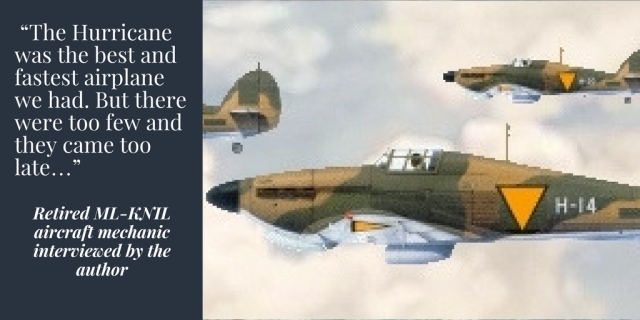
“The Hurricane was the best and fastest airplane we had. But there were too few and they came too late…” said the old Indonesian, who had served as a mechanic in the KNIL Air Arm during those fateful early months in 1942.
“Hurricanes?” I asked as I sat upright in surprise. Even though I was still a schoolboy, I already knew something about KNIL equipment. And I had never heard about Hurricanes in Java.
“Sure, the Brits delivered a bunch of them and we put them together in an old warehouse”.
It now is many years ago since I talked with that old man. I tried to press him for more information, but it was more than forty years ago and the memories were obviously painful. And when he finally talked, I clearly remember the impact his tale had on me. He didn’t speak much about Hurricanes, but told me how he and several others had survived the Japanese onslaught on Java and had tried to make for Australia in a small fishing vessel. How most of them had perished of hunger and thirst before they were rescued by the Australian navy. How he had fought his way back home, only to find his wife and kids murdered during the “Bersiap”, that infamous period of anarchy and random killings by rabid, blood-thirsty mobs that called themselves Islamists. The story of his life planted the seed for what now is the “Java Gold” series of novels. And to honour him, I dedicate this post to him.
Background
The war in Europe had exploded the pre-war myth of the bombers’ invulnerability. Fast, well-armed fighters shot them down by the score. It suddenly dawned on the Dutch government-in-exile that a great number of modern fighters would be needed to defend their revenue generating colony against Japanese aggression. And in 1940, there wasn’t a single fighter in the Dutch East Indies, apart from a few antiquated P6 “Hawks” in storage!
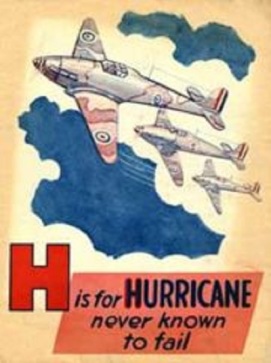
Image from a WW2 British Alphabet book
Jostling with all other countries that found themselves in dire peril, the hurriedly established Dutch Purchasing Commission scoured the market and bought whatever they could lay their hands on – Brewster Buffaloes, Curtiss P-75 Hawks and CW-21 Interceptors – to plug the gap in a hurry.
But the need for a first class frontline fighter was paramount and the Hawker Hurricane was an obvious choice. However, getting them delivered was something else. To have them built in the UK would be impractical (because of the distance) and production capacity was not available anyway.
On learning that the Canadian Car & Foundry Co. Ltd at Fort William, Ontario, was tooling up to mass-produce Hurricanes in Canada, the commission hurriedly struck a deal with them. A letter of intent for the delivery of 100 Hawker Hurricane Mk.II’s was signed on August 11, 1941. Afraid to put all their eggs in one basket, the commission then went and negotiated with Bell Aircraft for a possible delivery of 72 P-39 ‘Airacobra’s’. Both Bell and the US Government reacted positively and the Canadian order was slightly reduced. On November 29, 1941, a contract was signed for 72 Hurricanes, to be delivered in monthly batches of 15 aircraft, starting in May 1942. An emergency delivery request for twelve Hurricanes fell flat because of a lack of powerplants.
The Canadians started to work immediately and at least one Hurricane (Serial AM270) is reported to have been built to Dutch specifications and used as a test airframe by CCF.
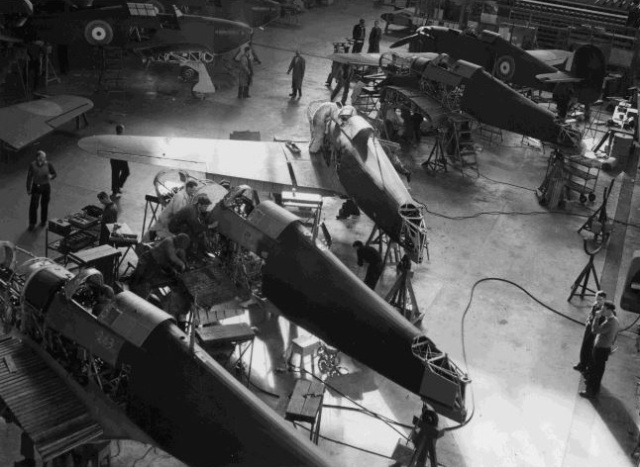
The Hurricane assembly line at Canadian Car & Foundry, Fort William, Ontario
Alas, the joy of having at least secured a steady delivery of frontline fighters was short-lived. The Japanese surprise attack on December 7, 1941made it clear the ordered Hurricanes would arrive too late.
Due to the rapid Japanese conquest of Malaya and the disastrous losses of Allied air power, the situation in Malaya rapidly became critical, The delivery of 50 crated Hurricanes to Singapore on January 13 did little to change this. They went into action on January 20, attacking 27 unescorted Japanese bombers over Singapore and shot down eight. From then on, the Japanese sent escorting fighters along and the Hurricanes failed to tilt the balance.
Steadily increasing Japanese air raids on the Singapore airfields whittled away the protecting fighter force of Buffaloes and Hurricanes and, by the end of January, it was decided to move most of the surviving aircraft to Sumatra. Thus, when 48 Hurricanes were launched on January 27 from the carrier HMS Indomitable, they were routed via Batavia to Palembang P2 in Sumatra.
The arrival of the Hurricanes
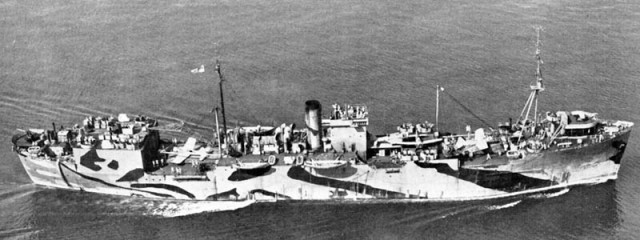
Aircraft Transport HMS Athene seen here as a seaplane tender
On February 4, 1942, HMS Athene reached Batavia, Java, via the cape. On board were 39 crated Hurricanes, a pool of 15 pilots and the ground staff of 242, 258 and 605 squadrons. In view of the rapidly deteriorating military situation in Malaya, it was decided to unload the Hurricanes and disembark the troops in Batavia. Furthermore, it was decided to have the remaining crated Hurricanes shipped from Singapore to Java. The Dutch freighter Phrontis, took four of them and six were taken aboard the Derrymore. The Derrymore, packed with Singapore refugees, was sunk by a Japanese submarine at only 60 miles from Batavia. However, the Phrontis (equally overloaded with refugees) arrived safely. By February 9, 1942, a total of 43 crated Hurricanes had reached Tanjong Priok, the port of Batavia.

The only known photograph of KNIL Hurricanes on Java, seen here on the road between Tanjong Priok and Kemajoran
The desperately needed fighters were erected right there and transported by road to Kemajoran where a team consisting of RAF, ML-KNIL and KNILM personnel worked shifts around the clock in an impressed KNILM hangar. Though hindered by a lack of tools and experience, the first Hurricanes were test-flown by RAF pilots five days after their crated arrival.
RAF and ML-KNIL pilots ferried them to Tjililitan, from where six were flown to Palembang I on February 10, 1942, eight went to PI on February 13 and a final batch of nine was ferried to PI on February 14. Eight Hurricanes went to the RAF reserve in Java and the remaining twelve Hurricanes were handed over to the Dutch forces.
In Dutch Service
The Hurricanes were officially handed over to 2.VLG.IV on February 10. This squadron had been badly mauled on February 3 during a massive Japanese bomber raid on Surabaya. All 13 available Curtiss CW-21b “Interceptors” had been scrambled from their base at Tanjong Perak but they were attacked from above and behind by sixteen or more Japanese fighters. Seven Interceptors were shot down and three badly damaged. Three Dutch pilots were killed and three severely wounded, while the squadron had managed to shoot down one Japanese fighter and damage another.
On February 13, the remaining pilots of 2 VLG IV flew to Tjililitan to “pick up” their new machines in an attempt to resurrect the badly mauled squadron. This proved not to be an easy task. The differences between the KNIL and British equipment, notably oxygen gear and radio’s caused serious problems. In a desperate bid to speed up conversion to the new type, 1st Lieutenant J.B.H (Jan) Bruinier was ordered to coordinate the efforts. This was based on his RAF service during 1940 and 1941, flying with Nos 92 and 611 squadrons. The fact, that these squadrons were equipped with Spitfires seems to have escaped the commanding officer’s attention.
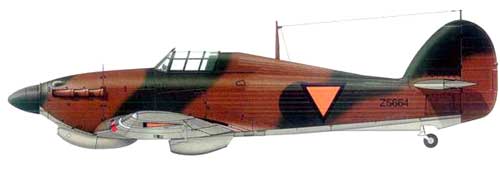
An artists impression of a Dutch Hurricane IIb, the desert dust filter still attached. When removed, the aircraft was 30 mph faster. Source: Wingspalette
On February 16, the squadron transferred to Kalidjati for intensive training and arrived in very bad weather. Being the first to land, Lt. Bruinier’s wheels got stuck in the soggy (grass) runway and his machine was badly damaged. The next day, February 17, another Hurricane was lost when Sergeant Hermans suffered an in-flight engine failure and had to crash-land at Kalidjati.The squadron could work on their training program for a week but this caused some irritation with the RAF squadrons and 2 VLG IV was ordered to fly daily “standing patrols”.
On February 25, 1942, eight Hurricanes were scrambled to intercept an incoming Japanese raid. After a two-hour patrol at 18.000 feet, no Japanese bombers were found and the Hurricanes returned to refuel. Two Hurricanes had already touched down and a third, flown by Sergeant Jacobs, was about to land when Japanese fighters struck. Jacobs tried to take off again but his Hurricane was riddled by Japanese bullets. He walked away from his crash but the Hurricane was a total loss. The other airborne Hurricanes, already low on fuel, engaged the Japanese in a frantic but short dogfight before they had to break off the action. Three of them landed at Kalidjati, where Ensign Hamming’s Hurricane ended up in a bomb crater. The remaining two Hurricanes landed at the Tjikampek field that held a stock of the required 100 octane fuel. Just after they had returned to Kalidjati, the Japanese struck again, bombing and strafing this time. Hamming’s Hurricane was shot up and the already questionable runways were badly damaged. Of the eight Hurricanes that took off that day, two were damaged beyond repair and two were damaged but repairable.
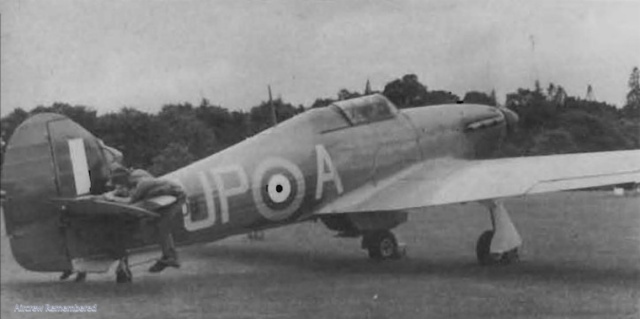
RAF no 605 Sqn Hurricane (Source: Aircrew Remembered)
As Kalidjati was now within Japanese bomber and fighter range, it was decided on February 26 to transfer the remaining seven Hurricanes to Ngoro (Blimbing) near Surabaya, a well-hidden field they would share with the P-40’s of the 17th Pursuit Squadron USAAF. This sudden move caused severe logistical problems again. It was not before February 28 that the urgently needed oxygen equipment, hydraulics and ammunition arrived. But the crystals for the pre-set channels of the radio sets had not been shipped.
During the night of February 28 / March 1, the Japanese forces invaded the Java north coast at three different locations. All available Hurricanes and USAAF fighters were sortied to attack the Japanese landing barges at Kragan and Banten Bay. During a very low-level attack, Lt. Bruinier’s Hurricane hit a Japanese barge with its prop and he had to make a forced landing at Madiun, followed by Sgt.Major Boonstoppel (reason unknown).
The remaining five Hurricanes (and the USAAF P-40’s) returned safely to Ngoro. A little later, and after being harassed by USAAF P-40’s until they saw the Dutch markings, a ML-KNIL Lockheed 12 arrived, delivering the badly needed radio crystals. Alas, the small transport had been shadowed to the still hidden airfield by two Japanese Zeroes that immediately carried out a strafing attack. All aircraft on the field weer destroyed or damaged beyond repair, with the exception of two Dutch Hurricanes. All damaged airframes were set on fire and what was left of the 17th Pursuit Squadron was evacuated to Australia.
The Dutch decided to fly the two surviving Hurricanes to Andir (Bandung). This was to be done by Lt. Marinus and Ensign Vink, the latter never having flown a Hurricane before… After a five-minute (!) cockpit instruction, Vink managed to take off from Ngoro. But during his flight, he got fuel transfer problems and decided to land at the Wirasaba field to have them fixed. Landing a Hurricane for the first time, he “pranged” the machine and shattered the wooden prop. As the Wirasaba field was to be evacuated, the Hurricane and two damaged Glenn Martin bombers were set afire by the ground troops.
Marinus found he was low on fuel and decided to land at the new and unfinished Surakarta field. Its runway had already been demolished, so he put the Hurricane down on a dry rice paddy. After staying overnight, he found out there was no 100 octane fuel available. In the end he had his Hurricane filled up with whatever was available, in this case standard car fuel. But when he tried to take off on March 2, his Merlin engine lost power because of the unsuitable fuel. Somehow, he survived and walked away from the crash but the Hurricane was a total loss.
But Sgt.major Boonstoppel had the worst luck of all. After flying from Madiun to Andir, he was sent to Pameumpeuk to refuel. Unfortunately, at that field, only 90 octane fuel was stocked. Stoically, he flew on to Maospati, where he found that this field was also being evacuated. In the end, he returned to Andir, still low on fuel. Next morning, March 3, he was ordered to join an attack on the Japanese forces landing at Eretan Wetan. But when he came to the field, he found the prop removed from his Hurricane by some overzealous ground crew, apparently to “repair” Vinks pranged Hurricane at Wirasaba. The prop was mounted again in a hurry, but Boonstoppel was too late to join the strike.
This ended the operational life of the Dutch Hawker Hurricanes. A single Hurricane fell into Japanese hands after the Dutch East Indies capitulated on March 8, 1942
Aircraft delivered by HMS Athene and MV Phrontis
Hurricane IIA Z2581; DG614 Hurricane IIB Z5317; Z5319; Z5341; Z5437; Z5546; Z5546; Z5555; Z5556; Z5602; Z5609; Z5612; Z5616; Z5619; Z5622; Z5664; Z5682; Z5683; Z5690; Z5691;BD778; BG677; BG677, BD890; BD892; BD896; BD927; BE149; BE194; BE206; BE210; BE218; BE225; BE293; BE332; BE333; BE362; BE363
So far, the only confirmed aircraft operated by the ML-KNIL were Z5664 and Z5683.
Sources:
Axis history Forum – contributions by Peter C. Boer, Jos Heyman;
Hurricanes over Singapore – Brian C. Cull;
Hawker Hurricane Mk.I – IV – Martin Chorlton
Shorty, an aviation pioneer- James Glassco Henderson
Canadian Hurricane Production – Google Groups – Geoffrey Sinclair
Author’s collection and documentation

I just love to learn things I never knew about.
LikeLike
I am now researching on RCAF 410 squadron based at RAF Drem in 1942. It’s not on Souvenirs de guerre right now but on another blog. I will reblog it on Souvenirs de guerre so you will see something never seen before.
LikeLike
Merci Pierre! Je suis trés interessé!
LikeLike
I will have more exclusive pictures tomorrow.
I just can’t wait.
LikeLike
Very interesting, thanks for this blog
LikeLike
My pleasure!
LikeLike
Thank you so much for your work.
As a decendent from the Dutch-East Indies with a deep interest in warplanes of the era these things were not known to me before. One by one, your articles are highly addictive 🙂
Greetings from Holland, Richard
LikeLike
Hi Richard,
My sincere apologies for reacting so late to your kind comment
For personal reasons, I was not able to work on my blog for a long time.
But now I am back and will take up the thread.
Another bit of information: I am currently bundling and editing all published and yet unpublished posts into a single, enhanced and much-expanded narrative which I will publish later this year as a book with the title “One Way Ticket to Java.”
Thanks for visiting my blog
Robert Kingsley
LikeLike
Richard,
I was thinking that, as you’re so interested in the former Dutch East Indies, you might like to read the books I have published so far in the “Java Gold” Series. This series is, what one could call, ‘historical fiction’, a fictional story set against a framework of verifiable historical facts. Book 1 starts early in 1942 in Java and returns there when the war is over. Half of Book 2 is situated in the postwar Dutch East Indies and highlights the struggle for independence and all kind of other seldom mentioned activities
Have a look at Amazon.
The books are available as e-book and paperback
Robert Kingsley
LikeLike